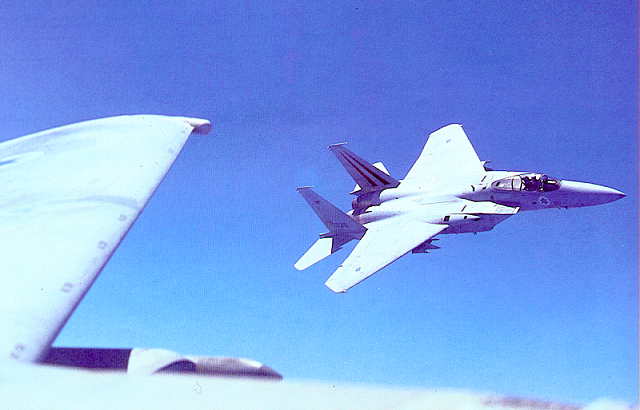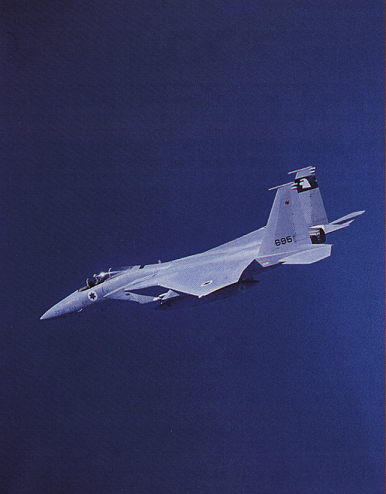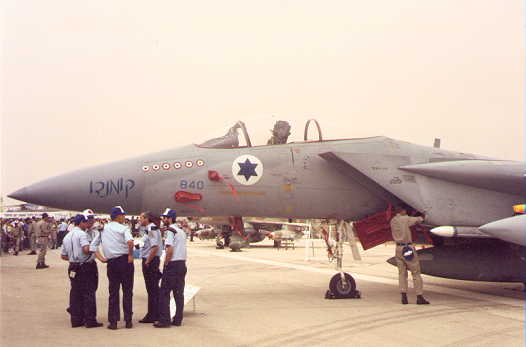

In air-to-air combat in Vietnam, lightweight Soviet-made fighters, the MiG-17,19 and 21, had proved deadly opponents for the large and capable F-4 Phantom in close combat. Disappointed with the air-to-air combat results achieved, the U.S Air Force recognized the need for an air superiority fighter that would dominate any future fighting, and in 1965 the USAF issued the FX requirement for such a fighter. Not only did the aircraft have to prevail in a scenario where it was outnumbered by small and versatile fighters, but in 1967 the MiG-25 Foxbat was revealed to the world, and the new American fighter had to defeat this newest threat, higher flying and faster than any previous Soviet fighter. Lacking better intelligence, The MiG-25 was attributed with performance that far outclassed anything that the West had to offer.
Picked out of 8 aircraft manufacturers, McDonnell Douglas was awarded the FX contract on December 23rd 1969. The first aircraft was roled out on June 26th, 1972 and took off on its maiden flight on July 27th. The original F-15 Eagle versions, the A and B, have since been superseded by the C and D variants and by the F-15E Strike Eagle, with better air-to-ground capabilities while preserving its air-to-air capabilities. More than 25 years after its service entry, the Eagle is still considered the best air superiority fighter in the world and is operated by the U.S.A, Japan, Israel and Saudi Arabia. While no Eagle has ever been shot down in combat, F-15s have shot down over 90 opponents, the majority of these while in service with the Israeli Air Force.
 The Israeli aqcuisition of the F-15 Eagle was initiated under the Peace Fox programme in 1975 and Israel became the type's first export customer. The requirement for a new air superiority fighter emerged after the 1973 Yom-Kippur war and the great changes the IAF underwent to deal with threats revealed in that war (these changes included the aqcuisition of the F-15, F-16, and Cobra gunships to name a few). The first and foremost Arab threat to Israeli air supremacy was the MiG-25, operating from Arab countries, routinely overflying Israel unhampered. The first 4 IAF Eagles arrived on December 10th 1976 and on the same day scored their first kill. Arriving on Friday, within the Jewish Sabbath, this prompted religious parties in Israel's parliament, the Knesset, to topple the government of Prime Minister Itzchak Rabin. The first 4 were nicknamed "Sufa", "Sa'ar" (Storm and Tempest, the same names given to the first IAF Gloster Meteors), "Barak" (Lightning) and Ra'am (Thunder), while the type was commonly known as the "Baz" (Falcon). The remaining 21 aircraft of the initial order, 19 F-15As and 2 F-15Bs were delivered during 1977 and with the arrival of the Eagle, MiG-25 flights over Israel ceased to take place.
The Israeli aqcuisition of the F-15 Eagle was initiated under the Peace Fox programme in 1975 and Israel became the type's first export customer. The requirement for a new air superiority fighter emerged after the 1973 Yom-Kippur war and the great changes the IAF underwent to deal with threats revealed in that war (these changes included the aqcuisition of the F-15, F-16, and Cobra gunships to name a few). The first and foremost Arab threat to Israeli air supremacy was the MiG-25, operating from Arab countries, routinely overflying Israel unhampered. The first 4 IAF Eagles arrived on December 10th 1976 and on the same day scored their first kill. Arriving on Friday, within the Jewish Sabbath, this prompted religious parties in Israel's parliament, the Knesset, to topple the government of Prime Minister Itzchak Rabin. The first 4 were nicknamed "Sufa", "Sa'ar" (Storm and Tempest, the same names given to the first IAF Gloster Meteors), "Barak" (Lightning) and Ra'am (Thunder), while the type was commonly known as the "Baz" (Falcon). The remaining 21 aircraft of the initial order, 19 F-15As and 2 F-15Bs were delivered during 1977 and with the arrival of the Eagle, MiG-25 flights over Israel ceased to take place.
The F-15 went into action for the first time during March 1978, flying top cover for Israeli ground operations against Palestinian terrorists in Southern Lebanon. Only on July 27th 1979 did the Eagles score their first air-to-air victory. The IAF had sent the Eagles to protect aircraft flying attack sorties against PLO targets in Lebanon when 8 Syrian MiG-21s attempted to engage the attacking aircraft. Five MiG-21s were downed using missiles and cannons in the Eagle's first engagement worldwide. Four more MiGs were downed in September 1979, another MiG in late 1980 and another pair on December 31st, 1980. As formerly mentioned, one of the prime reason for the developement of the F-15 and its acquisition by the IAF had been the MiG-25 Foxbat, which had frustrated the IAF in the early 1970s. On February 13th, 1981, an opportunity was finally awarded to the F-15 to engage the Foxbat, and in the first worldwide kill of the type, an IAF F-15 shot down a Foxbat. Another MiG-25 was downed on July 29th and a third on August 31st, 1982, in a joint F-15 - Hawk SAM ambush. F-15As also flew top cover for F-16 Fighting Falcons during their famous attack of the Osirak Nuclear Plant in Baghdad, on June 7th, 1981, escorting the Falcons all the way to the Iraqi capital.
On June 6th, 1982, Israel began operation "Peace For Gaillee" and its ground forces pushed into Lebanon in pursuit of Palestinian terrorists. Contact was expected to be made with the Syrians, the main power broker in Lebanon, but during the first days of the fighting the Syrians mainly kept their forces at bay, only a few dogfights taking place. Only as IDF forces continued their push northward into Lebanon, approaching areas under Syrian control, did contact become inevitable and the IAF got to exercise its full ability. On June 9th a single IAF pilot managed to shoot down four Syrian MiGs and land his aircraft after it was hit by an air-to-air missile. By the end of the first week of hostilities, over 85 Syrian aircraft had been shot down, 40 of them by IAF F-15 Eagles. Most kills were made with either the AIM-9 Sidewinder or the Israeli Python 3 short range missiles, a few (including the various MiG-25s) were shot down with the AIM-7 Sparrow, while a number of aircraft were cannon kills.


 back to the IDF/AF page
back to the IDF/AF page